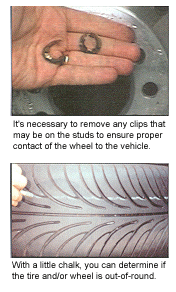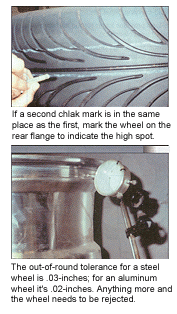In past issues of Tomorrow’s Technician, we’ve covered the technical aspects of custom wheels and what you need to know about how to sell them. Now we will discuss another important part of the equation: Mounting and Balancing.
I don’t intend to explain how to mount and balance tires and wheels in this article. You ought to know how to do that. But I do want to offer some insight on techniques and procedures to help you to diagnose ride problems and prevent them from occurring.
Check Things Out
Before placing a tire/wheel assembly on a vehicle, inspect the drums and discs. Clean all mounting surfaces so that your assembly fits flush against the vehicle. Also, remove any clips that may be on the studs. Remember, the mounting pad on aftermarket wheels is flat; OE wheels have a pocket to allow the clips to recess into the mounting pad. You must remove these to ensure proper contact of the wheel to the vehicle.
 Balancing
Balancing
Now that the vehicle is ready, mount the tire on its wheel, and then place on the balancer. While balancing check for repeatability before proceeding to the rest. This will ensure that you don’t have an error in your balancing technique or an error in your balancer itself.
First, check the accuracy of your balance by pulling the wheel off the balancer, rotate it at least 90 and then replace it, being sure to tighten it back up in a different position. Spin it up and check your measurements. If your reading is more than .25-ounce off from the previous reading, then a mounting error occurred.
While the assembly is spinning on the balancer, watch for a hop (lateral) or side-to-side (radial) movement. If you see either of these, it would be a good idea to diagnose what is causing the excessive movement. If the balancer is calling for an excessive amount of weight, deflate and rotate the tire 180. Rebalance to see if the amount of weight called for is significantly less.
 Note: Most aftermarket wheels are lug centric and need to be balanced through the lug holes with a flange plate adapter, not through the centerbore. If you get inconsistent results, pay close attention to your technique, inspect the cones, flange plate, balancer shaft and the nut to make sure that they haven’t been damaged.
Note: Most aftermarket wheels are lug centric and need to be balanced through the lug holes with a flange plate adapter, not through the centerbore. If you get inconsistent results, pay close attention to your technique, inspect the cones, flange plate, balancer shaft and the nut to make sure that they haven’t been damaged.
Out-of-Round?
You may need to determine if the tire, wheel or both are out-of-round. Using common items such as tire chalk and a stationary metal stand, we can determine which is the likely cause. First, place the mounted tire/wheel assembly on the balancer and tighten. Spin the assembly by hand, then use the chalk to gradually move close enough to cause a mark on the tire tread. Hold the chalk steady. A high spot will show a mark.
Now, loosen the assembly, spin it 180 on the shaft and retighten. Spin the assembly by hand once more and repeat the procedure moving slightly off to one side of the previous mark. If the second chalk mark(s) is in the same place(s) as the first (indicating that the assembly is centered on the balancer properly), then mark the wheel on the rear flange to indicate the high spot area(s).
Break the tire from the rim and rotate 180. Re-inflate and repeat the above steps. If your chalk mark doesn’t hit a high spot, chances are that the high spot on the tire and any high spot on the wheel were matched up before. No mark means the low spot on the tire is matched up with the high spot on the rim to form a more uniform assembly. This should greatly reduce vibration causing the ride comfort problem.
What if that didn’t work?
If you still have a high spot on the tire after rotating it, check the mark against the mark on the rear flange of the wheel. If they are near equal, break the tire off of the wheel and bolt the wheel onto the balancer by itself. Spin it up by hand and look for any run-out.
If you see movement where the chalk was marked on the rear flange, you may have an out-of-round wheel. The tolerance for a steel wheel is .03-inch (1/32nd-inch) and .02-inch (1/50th) for an aluminum wheel. Before rejecting a wheel, check the wheel to determine the exact amount of run-out using a dial indicator.
If the wheel is beyond these specs, call the supplier and get another wheel. If it is within specs, you may want to try another tire.
Another tire may match your wheel better and balance without any problems.
Final Tip
If you are getting ride complaints and are finding that the balance is off when you check it, the tires may have slipped on the rim after you balanced them.
To find out, index the tire to the wheel with chalk mark on the back of the tire and wheel before letting the customer drive away. If they return with a ride complaint, you will be able to tell if the tire has slipped on the rim and is now an out-of-balance assembly. This is especially common on large trucks and SUVs. Indexing a tire to a wheel is quick and easy and can help you diagnose a problem without having to spend a great deal of time.


